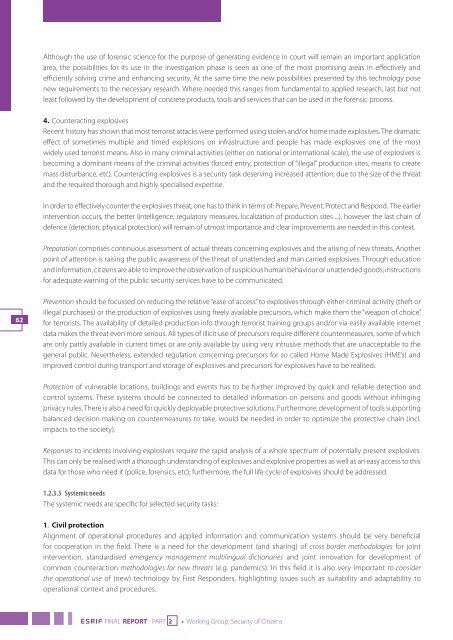I527-290 ESRIF Final Report (WEB).indd - European Commission
I527-290 ESRIF Final Report (WEB).indd - European Commission
I527-290 ESRIF Final Report (WEB).indd - European Commission
Create successful ePaper yourself
Turn your PDF publications into a flip-book with our unique Google optimized e-Paper software.
62<br />
Although the use of forensic science for the purpose of generating evidence in court will remain an important application<br />
area, the possibilities for its use in the investigation phase is seen as one of the most promising areas in eff ectively and<br />
effi ciently solving crime and enhancing security. At the same time the new possibilities presented by this technology pose<br />
new requirements to the necessary research. Where needed this ranges from fundamental to applied research, last but not<br />
least followed by the development of concrete products, tools and services that can be used in the forensic process.<br />
4. Counteracting explosives<br />
Recent history has shown that most terrorist attacks were performed using stolen and/or home made explosives. The dramatic<br />
eff ect of sometimes multiple and timed explosions on infrastructure and people has made explosives one of the most<br />
widely used terrorist means. Also in many criminal activities (either on national or international scale), the use of explosives is<br />
becoming a dominant means of the criminal activities (forced entry, protection of “illegal” production sites, means to create<br />
mass disturbance, etc). Counteracting explosives is a security task deserving increased attention, due to the size of the threat<br />
and the required thorough and highly specialised expertise.<br />
In order to eff ectively counter the explosives threat, one has to think in terms of: Prepare, Prevent, Protect and Respond. The earlier<br />
intervention occurs, the better (intelligence, regulatory measures, localization of production sites ...), however the last chain of<br />
defence (detection, physical protection) will remain of utmost importance and clear improvements are needed in this context.<br />
Preparation comprises continuous assessment of actual threats concerning explosives and the arising of new threats. Another<br />
point of attention is raising the public awareness of the threat of unattended and man carried explosives. Through education<br />
and information, citizens are able to improve the observation of suspicious human behaviour or unattended goods; instructions<br />
for adequate warning of the public security services have to be communicated.<br />
Prevention should be focussed on reducing the relative “ease of access” to explosives through either criminal activity (theft or<br />
illegal purchases) or the production of explosives using freely available precursors, which make them the “weapon of choice”<br />
for terrorists. The availability of detailed production info through terrorist training groups and/or via easily available internet<br />
data makes the threat even more serious. All types of illicit use of precursors require diff erent countermeasures, some of which<br />
are only partly available in current times or are only available by using very intrusive methods that are unacceptable to the<br />
general public. Nevertheless, extended regulation concerning precursors for so called Home Made Explosives (HME’s) and<br />
improved control during transport and storage of explosives and precursors for explosives have to be realised.<br />
Protection of vulnerable locations, buildings and events has to be further improved by quick and reliable detection and<br />
control systems. These systems should be connected to detailed information on persons and goods without infringing<br />
privacy rules. There is also a need for quickly deployable protective solutions. Furthermore, development of tools supporting<br />
balanced decision making on countermeasures to take, would be needed in order to optimize the protective chain (incl.<br />
impacts to the society).<br />
Responses to incidents involving explosives require the rapid analysis of a whole spectrum of potentially present explosives.<br />
This can only be realised with a thorough understanding of explosives and explosive properties as well as an easy access to this<br />
data for those who need it (police, forensics, etc); furthermore, the full life cycle of explosives should be addressed.<br />
1.2.3.3 Systemic needs<br />
The systemic needs are specifi c for selected security tasks:<br />
1. Civil protection<br />
Alignment of operational procedures and applied information and communication systems should be very benefi cial<br />
for cooperation in the fi eld. There is a need for the development (and sharing) of cross border methodologies for joint<br />
intervention, standardised emergency management multilingual dictionaries and joint innovation for development of<br />
common counteraction methodologies for new threats (e.g. pandemics). In this fi eld it is also very important to consider<br />
the operational use of (new) technology by First Responders, highlighting issues such as suitability and adaptability to<br />
operational context and procedures.<br />
<strong>ESRIF</strong> FINAL REPORT - PART 2 • Working Group: Security of Citizens

















